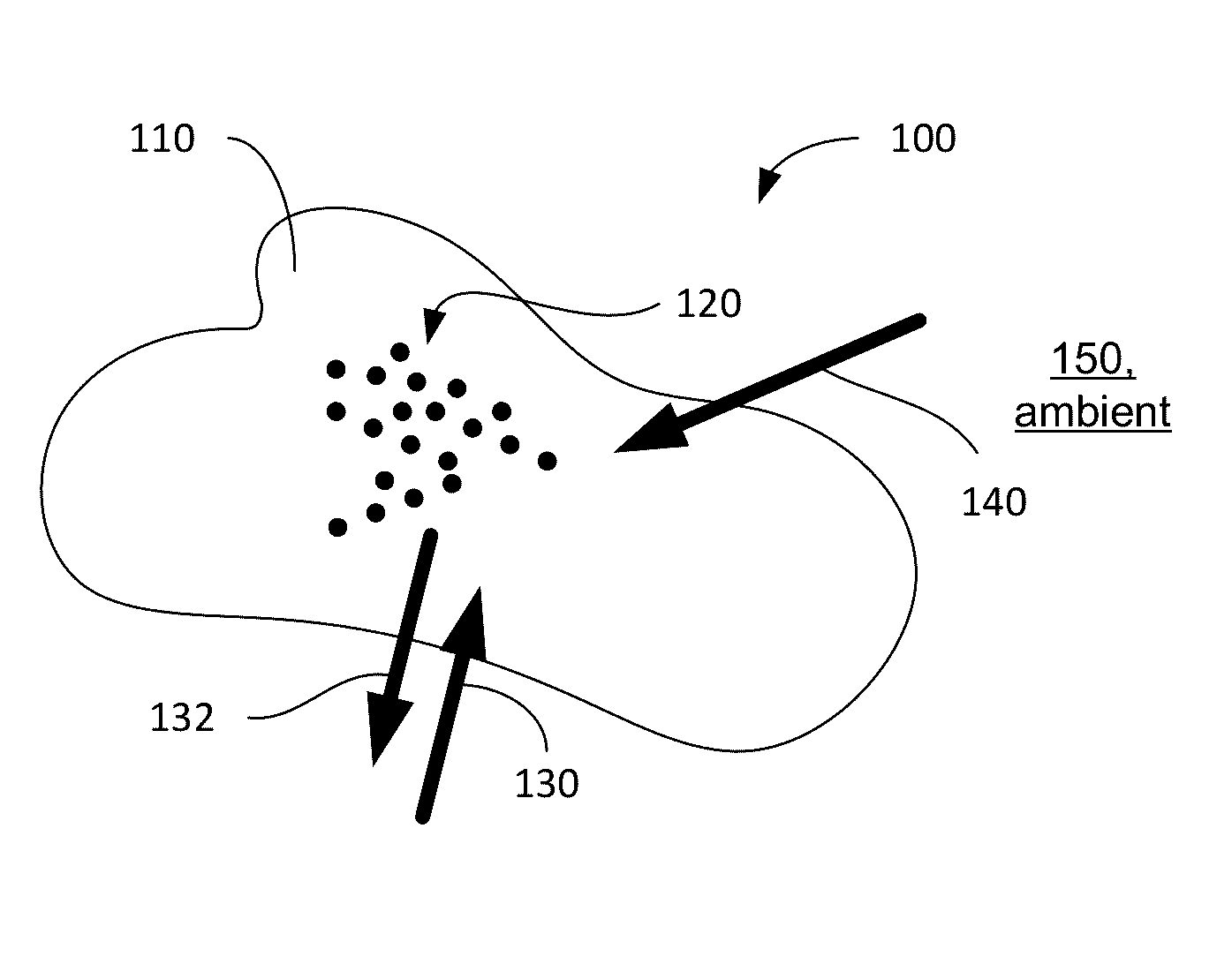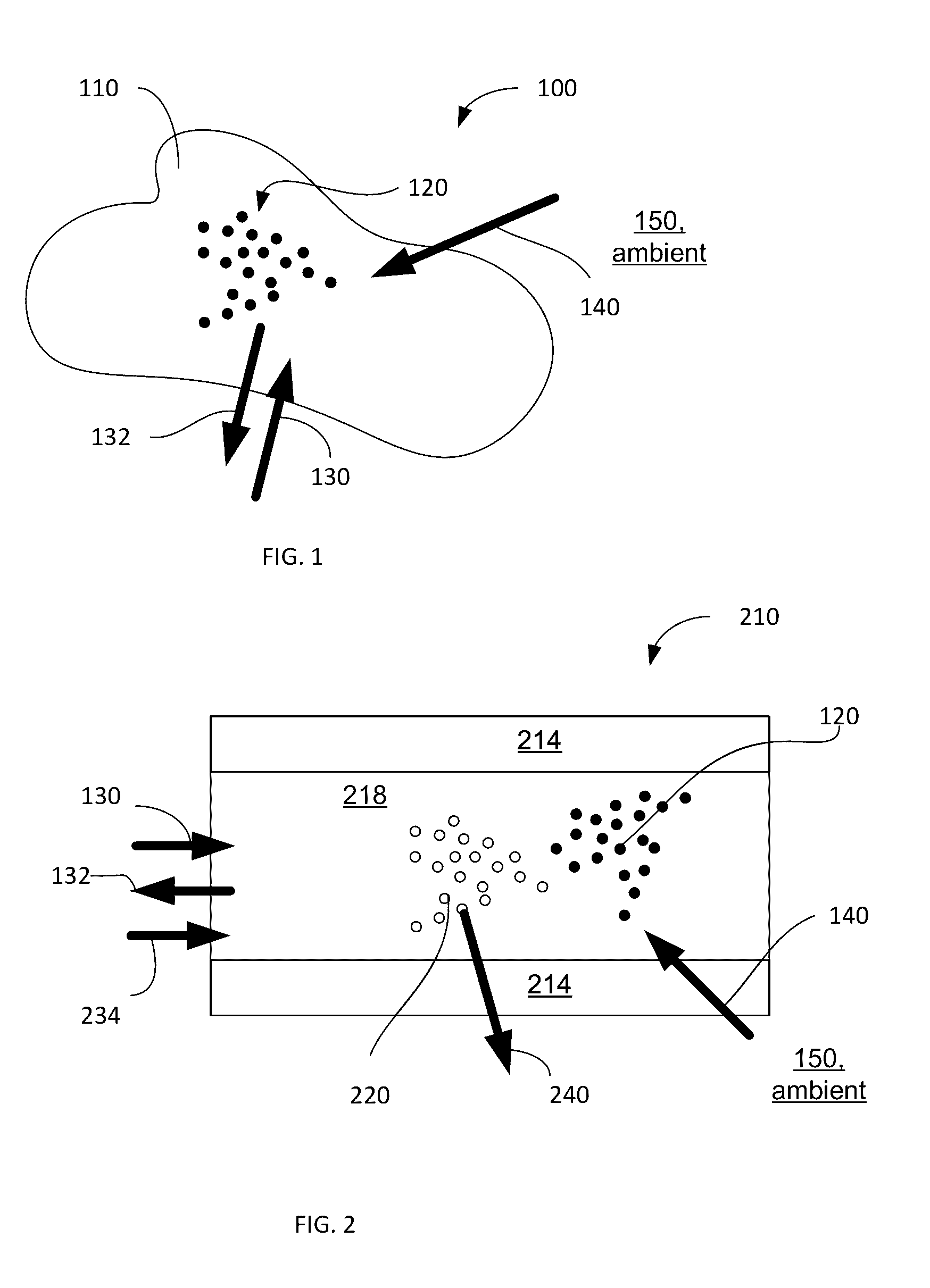Light-guiding hydrogel devices for cell-based sensing and therapy
a technology of cell-based sensing and hydrogel, which is applied in the field of light-guiding hydrogel devices for cell-based sensing and therapy, can solve the problems of high optical loss in biological tissue, unresolved current phototherapy modalities, etc., and achieve the effects of mechanical flexibility, increased and improved molecular weight of hydrogels
- Summary
- Abstract
- Description
- Claims
- Application Information
AI Technical Summary
Benefits of technology
Problems solved by technology
Method used
Image
Examples
examples of embodiments
Example 1
[0053]As shown schematically in FIG. 1, an embodiment 100 of the assembly of the invention includes, in part, a light-collecting three-dimensional body 110 containing a polymer hydrogel material that encapsulates sensory receptors or cells 120. The body 110 may be structured in various fashions, for example as a slab waveguide or a thin-film waveguide discussed in U.S. patent application Ser. No. 14 / 239,607; or as a 3D body having a different shape. In a specific case, when the polymer hydrogel body 110 is configured as a lightpipe (for example, a rectangular flexible slab with dimensions on the order of several mm by a millimeter by several tens of millimeters), it may include an optical-lightguide core and / or cladding (as known in the art; not shown in FIG. 1) that facilitate light-guiding within the body. The optical index distribution in such lightguide has a predetermined profile judiciously chosen to facilitate guiding of light 130, 132 for delivery of light to and / or...
example 2
[0059]According to idea of the invention, at least a light source used for excitation of the elements 120 and / or 220 (or, possibly, both such a light source and an optical detector configured to register the optical response of the sensory receptors to the excitation light) may be integrated within the hydrogel body 110, 220. A hydrogel body 110 of the embodiment 500 of FIG. 5, for example (for simplicity shown to encapsulate only the sensory receptors 120) includes a light emitter 510 structured to be powered by an external energy source 514 via a wireless connection 520, for example by induction coupling from the transmitter of the external electronic circuitry 530. In one specific example, a single micro-LED (such as that described by R. Mandal et al. in “Wirelessly Powered and Controlled, Implantable, Multi-channel, Multi-wavelength Optogenetic Stimulator”; 2013 IEEE MTT-S International Microwave Workshop of RF and Wireless Technologies for Biomedical and Healthcare Applications...
example 3
[0060]In one implementation, schematically illustrated in FIG. 6, the hydrogel body 110 is formed inside the biological tissue 650 via injection of a liquid-phase material through a small-diameter injector 654 and in situ gelation following the injection. In one example, such material may include PEG-PLGA-OEG triblock copolymer, designed to be in a liquid phase at temperatures that are lower than the body temperature and initiate gelation at about 37° C. The injector is removable (as shown by a dashed line) and, in practice, is disposed of after the gelation of the body 110 with at least one of the sensory receptors and reflex elements encapsulated in it.
PUM
| Property | Measurement | Unit |
|---|---|---|
| optical penetration depth | aaaaa | aaaaa |
| temperatures | aaaaa | aaaaa |
| molecular weights | aaaaa | aaaaa |
Abstract
Description
Claims
Application Information
 Login to View More
Login to View More - R&D
- Intellectual Property
- Life Sciences
- Materials
- Tech Scout
- Unparalleled Data Quality
- Higher Quality Content
- 60% Fewer Hallucinations
Browse by: Latest US Patents, China's latest patents, Technical Efficacy Thesaurus, Application Domain, Technology Topic, Popular Technical Reports.
© 2025 PatSnap. All rights reserved.Legal|Privacy policy|Modern Slavery Act Transparency Statement|Sitemap|About US| Contact US: help@patsnap.com



